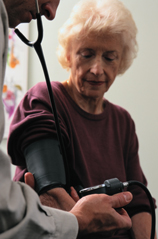Manage diagnosis, follow-up of depression systematically
Improvements to treating depressive symptoms led to improvements in A1c levels and blood pressure in one internist's practice. A systematic, manageable approach exists to diagnosis and treatment.
If you think it's not worth the time to address depression in primary care patients, think again.
“Once I started [addressing depression], I saw improvements in A1c and blood pressure in patients who had been making no progress with their diabetes and hypertension. If patients are depressed, they often won't follow through on medication adherence or diet changes that affect these other conditions,” said Damara N. Gutnick, ACP Member, an assistant professor of medicine and psychiatry at New York University's Langone Medical Center who sees patients at Bellevue Hospital Center.

In an Internal Medicine 2011 session on managing depression in primary care, Dr. Gutnick and co-speaker Kristin Remus, ACP Member, instructor of medicine at Beth Israel Deaconess Medical Center in Boston, outlined a systematic, manageable approach to diagnosis and treatment.
It begins with having patients fill out a two-item screening questionnaire for depression, the Patient Health Questionnaire (PHQ-2), in the waiting room. If a patient answers yes to either question, the patient should then be directed to complete the PHQ-9, a screener that was developed for use in primary care and has been validated for diagnostic assessment and follow-up of outcomes in racial and ethnically diverse populations. The PHQ-9, as well as instructions on scoring and other material, is available from the MacArthur Initiative on Primary Care and Depression.
The PHQ-9 is quick, easy to score and available in several languages, noted Dr. Gutnick. A value of 0 through 3 is assigned to each question based on how often a patient reports having experienced the symptoms described (such as tiredness or poor appetite) in the past two weeks.
“We use a cutoff of 10 [points] on the PHQ-9 to trigger the treatment algorithm, because below that you will detect dysthymic patients, but not necessarily those who are having most of the symptoms of major depressive disorder. In addition, the sensitivity and specificity of the test is still reasonable with this cutoff,” Dr. Remus said.
Patients who score between 10 and 14 on the PHQ-9 are diagnosed as moderately depressed; for them, after ruling out other medical causes for the patient's symptoms, one could consider prescribing medication and/or counseling, and discuss self-management support like exercise. Patients who score between 15 and 19 are considered to have moderately severe depression, and “are more likely to be started on medication right away … in this case, psychotherapy is usually important,” Dr. Remus said.
A patient who scores 20 to 27 is severely depressed, and referral to a psychiatrist for treatment should be considered, particularly if the patient has psychotic or manic symptoms, active suicidal ideation or attempts, substance abuse or dependence, severe psychosocial problems, severe personality disorder, or poor response to antidepressants after titration.
Follow-up should be completed within one to three weeks after an initial depression diagnosis to assess adherence to treatment (whether counseling, medication or self-management) and side effects of medication, if relevant, Dr. Remus said. This can be done by support staff like a care manager, she said. Suicide risk should also be assessed at this time, as this “risk sometimes increases as patients respond to treatment and become more energetic,” she added.
A recently published algorithm for assessing suicidality is the P4 screener, Dr. Gutnick said. For any patient who answers positively to question #9 of the PHQ-9 (which inquires about “thoughts that you would be better off dead or of hurting yourself in some way”) the first step is to determine whether the patient has “active thoughts” of self-harm. If he or she does, the clinician should determine the answers to the “four Ps”:
- 1. Does the patient have a Plan for self-harm?
- 2. Does the patient have a Past history of suicide attempt?
- 3. What is the Probability or likelihood of following through on a suicide plan? Probability can be determined by saying, “Having a plan and following through are two different things. How likely are you to actually hurt yourself?”
- 4. Are there “Protective factors,” or reasons why patients with a suicide plan are not at all likely to follow through? The most common protective factors can be classified as the “four Fs”: Family (i.e., “I wouldn't do this because of my kids”), Faith (i.e., “Suicide is against my religion”), Fear of failure (i.e., “I would be worse off if I attempted and didn't succeed”) and hope for the Future.
Based on the responses to the P4 screener, patients can classified as having a low, intermediate or high risk for suicide, Dr. Gutnick said.
The PHQ-9 should be repeated four to eight weeks after starting treatment, since “This is when we would expect the maximum response to treatment to occur,” Dr. Remus noted. At this time, a drop of more than five points on the PHQ-9, or an overall score less than 5, is considered an adequate response, and no change in treatment is needed. These patients should be followed monthly until remission, defined as a PHQ-9 score of less than 5 maintained for more than two months, then every six months after that, she said.
Patients who see a drop of two to four points at follow-up have had a possibly inadequate response to treatment, and it may be appropriate to increase or change medication, increase the intensity of psychotherapy, and/or increase self-management support measures. For those with a drop of one point or no change in their score, consider the same measures as those with a possibly inadequate response, in addition to consultation or referral to a specialist. In all patients in whom treatment is adjusted, repeat the PHQ-9 again in four to eight weeks, Dr. Remus recommended.
Bellevue Hospital Center uses a collaborative care model to manage depression, Dr. Gutnick said. A medical assistant administers the PHQ-2 and, if needed, the PHQ-9. If the latter is positive, the assistant circles the score to draw the attention of the primary care physician, who uses the score and the patient visit to determine a depression diagnosis and possible treatment.
A depression care team is then activated for follow-up, including a psychiatric nurse practitioner who can titrate or change medications if needed. The team members provide regular feedback to the physicians about patients.
“It's an active collaborative process between [physicians] and care managers,” Dr. Gutnick said. “I can offer suggestions for treatment, or step in if a problem becomes more acute.”




